Ecology final exam ( chapters: 10,12,13,14, and part of 5)
1/147
There's no tags or description
Looks like no tags are added yet.
Name | Mastery | Learn | Test | Matching | Spaced |
|---|
No study sessions yet.
148 Terms
The hair color of a hypothetical species of mammal is determined by a single gene. The black fur allele is dominant to the brown fur allele. If you cross two black-furred heterozygotes, what will be the ratio of fur colors in the offspring?
75 percent will have black fur, and 25 percent will have brown fur.
Protandry
The condition in which an organism begins life as a male and then changes into a female
monoecious
having both the male and female reproductive organs in the same individual; hermaphrodite.
what reproductive strategy does cicadas use
semelparity
A(n) __________ is a population adapted to its local environment.
ecotype
Small populations are subject to changes in allele frequencies simply due to random chance, such as the accidental death of an individual. This process is known as
genetic drift
The process by which one species gives rise to multiple species that exploit different features of the environment is called
adaptive radiation
"Fitness" describes an organism's __________.
contribution to future generations
is/are the units of inheritance on which natural selection can act.
Genes
Which of the following are basic components of the Hardy-Weinberg model?
Frequencies of two alleles in a gene pool before and after many random matings
What is the frequency of the A 1 A 2 genotype in a population composed of 20 A 1 A 1 individuals, 80 A 1 A 2 individuals, and 100 A 2 A 2 individuals?
0.4
Which of the following evolutionary forces could create new genetic information in a population?
mutation
Which of these was the first of the major events that stimulated an increase in the size of the human population?
the advent of agriculture
Which of these was the second of the major events that stimulated an increase in the size of the human population?
Industrial Revolution
Which of these was the third of the major events that stimulated an increase in the size of the human population?
the discovery of vaccines and the discovery of antibiotics
Currently, how large is the worldwide population of humans relative to Earth's carrying capacity for humans?
There is insufficient information to answer this question
A trade-off for having many offspring would be
that they would likely be small in size
Members of the California sheephead fish species begin their life as females and then become males. This is referred to as
sequential hermaphroditism
Organisms that invest all their reproductive energy into one event are said to be __________.
semelparous
An r-strategist is characterized by
density-independent mortality
According to the latest data, the global human population is predicted to
peak at 10 billion
Humans who have pets tend to be healthier than humans who do not have pets. Which of these terms applies to the relationship between a human and a pet?
mutualism
Which of these terms applies to the relationship between a dog and a blood-sucking tick?
parasitism
An egret eats insects stirred up by grazing animals. Which of these terms applies to the relationship between the egret and the grazing animal?
commensalism
Which of the following interactions would be considered predation?
+ -
Oxpeckers are birds native to Africa. They have been observed feeding on ticks on the backs of large mammals and were thought to reduce the number of ticks. Recent studies indicate that the tick load is unaffected by the oxpeckers, and the oxpeckers actually reopen old tick wounds and consume the mammals' blood. Ecologists are considering reclassifying the relationship between oxpeckers and large African mammals from __________ to __________.
mutualism; parasitism
If there is a single species (species 1) present with the carrying capacity of 500, and another competing species (species 2) with the same limiting resource becomes established in the area and has a population of 200, it will effectively change the carrying capacity for species 1 to __________.
300
Species having wide geographic distributions generally encounter a broader range of physical environmental conditions than species whose distribution is more restricted
True
A flower is not ideally matched with a pollinator that visits it daily. Why might that be?
The flower has several other pollinators with differing traits.
An organism's realized niche is always smaller than its fundamental niche
adaptive radiation
A taller plant shading those individuals below, and reducing available light, is referred to as
overgrowth competition
The alpha and beta terms represent the __________ in the Lotka-Volterra models of population growth
competition coefficients
Resource partitioning over a long period can result in natural selection that causes a shift in features of the species' morphology, behavior, or physiology. This is called __________
character displacement
Which of the following is a nonresource (or nonconsumable resource) that can influence the outcome of competition among plant species?
temperature
How can one grass species be dominant one year, while another is dominant a few years later and then the first becomes dominant again?
changes in precipitation across years
The __________ describes the range of conditions and resources that a species exploits as a result of interactions with other species.
realized niche
Coexisting species of wild cats differ in the size of their canine teeth, which corresponds to differences in their preferred species of prey. This outcome is most likely the result of
resource partitioning
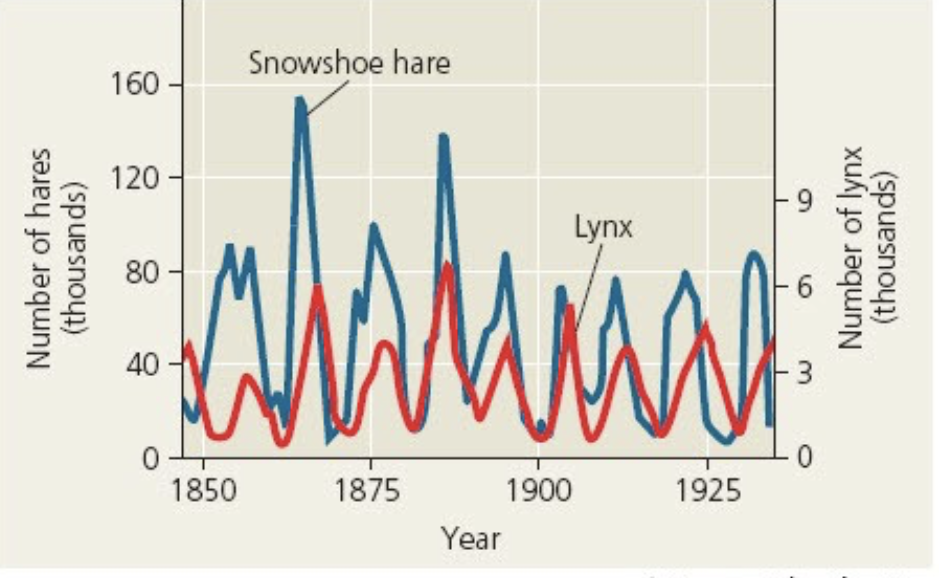
What do you observe about the relative timing of the peaks in lynx numbers and hare numbers?
Hare numbers typically peaked slightly before lynx numbers.
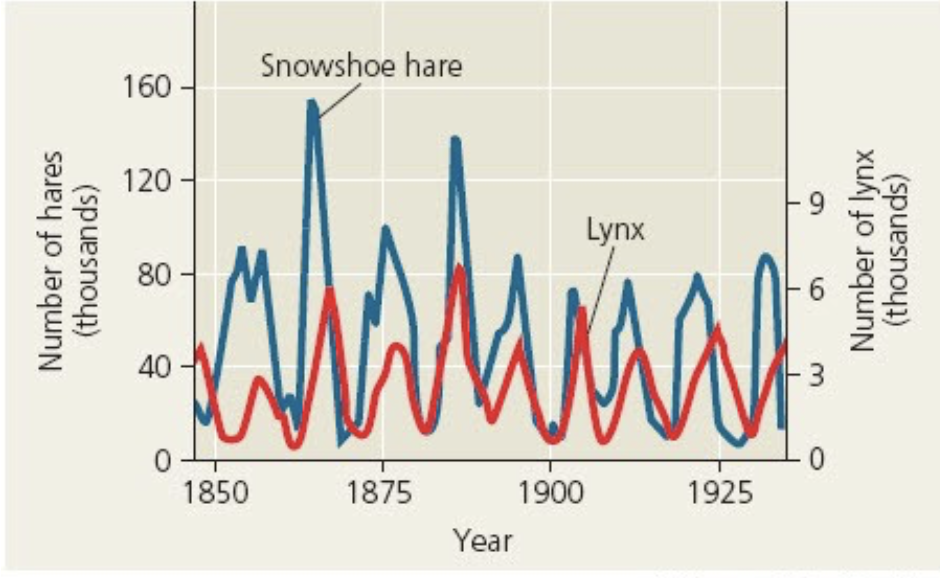
What might explain the observation that hare numbers typically peaked slightly before lynx numbers?
The lynx depend on the hares for food, but there is a delay between increased food availability and increased reproduction by the lynx.
In the Lotka-Volterra equations that represent predator-prey interactions, predators are a source of density-independent mortality for prey
False
According to the Lotka-Volterra equations for predator and prey populations, how many prey will be removed if the efficiency of predation is 0.02, the prey population is 1000, and the predator population is 10?
200
In a basic Lotka-Volterra predator-prey model, what happens if predator and prey populations are graphed in relation to time?
They begin to cycle
European kestrels feed on Microtus voles, with the "kill" rate, defined as the number of prey taken during the breeding season, as linearly proportional to the density of Microtus. This type of functional response is referred to as
Type I
What is maximum sustainable yield?
(The yield that allows for populations to recover to their pre-harvest levels)
a strategy that involves optimizing harvest of a particular species by keeping the population at an intermediate level and harvesting the species at a rate equal to the annual growth rate
From a landscape perspective: What habitats make up this landscape (it's not just a wetland).
Open water as in the river and wetlands seen by the vegetation and uplands
From a Conservation biology perspective: What natural products were harvested from this landscape? What happened such that the human inhabitants no longer lived there.
Alligator hides, cypress, and pine were harvested from the landscape. It became a USFWS refuge.
Yellow eye rings may facilitate what, for alligators?
It helped magnify the light into the eye (better night vision)
Alligators exhibit social behaviors and communicate in several ways (audible and visual). Briefly describe and indicate their purpose.
Head slapping, rising on their legs, bellowing for courtship through a subsonic water dance, male has a lower pitch
What are 'peat blow-ups'? How do they form and eventually what types of new habitat are created?
Peat blow-up occurs when methane and other gasses gather beneath the surface of a peatland leading to a sudden release of pressure, causing the peat to be ejected in an explosion. This leads to new vegetation growth but with a different community structure
What is the English translation of the Native American word 'Okefenokee'.
Land of the trembling earth
Insectivorous plants are common in Okefenokee but do not grow in deep water. How is it that the pitcher plants are growing in an area where the biologist is wading around up to his waist? Their habitat of eating insects is related to what water chemistry conditions?
Pitcher plants are on floating peat blow-ups, and the habitat of eating insects is related to low pH (so low nutrient & CEC is occupied by H+)
Red-cockaded woodpeckers: What are their habitat requirements? The pine species is Pinus palustris, but what characteristics of these trees do the RCWs depend on for making nest cavities? Explain the role of pine sap (resin) and the orientation of the nest cavity and how this enhances nest success.
Their habitat requirements are open pin forests, which are dominated by longleaf pines for their nesting and foraging needs, preferring larger older ones with red heart fungus. They use the Pine sap to deter predators, reducing nest predation.
Describe the alligator nest - why do you think it is above water (why not lay in water). How are eggs incubated (mother sits on nest???....I don't think so)... What preys on alligator nests?
They are incubated by dead and decaying plant material that is piled up and mixed with peat. They are preyed on by raccoon and bears.
What other reptile uses alligator nests in a relationship that could be described as commensalism (one species benefits, the other is not effected, as far as we know).
Red-bellied turtle
How do fire and water level fluctuations interact to create new ponds/lakes (i.e., depressions in the Okeefenokee landscape)?
The peat dries out and can burn out holes which can become new ponds
How does the mother alligator know her eggs are hatching out of the nest? What does she do to help her newly hatched young?
The babies call and the mother digs into the nest and carries them to the water
What abiotic factor influences gender in hatchling alligators?
Temperature warmer water leads to males hatching (above 90° F)
Although the refuge is largely wilderness and protected federal property, what construction issue may be causing problems within the refuge boundaries?
The installation of a sill
Life History
Lifetime pattern of growth development and reproduction (result of natural selection)
Age-specific patterns were quantified with
empirical data
Sx =
Age-specific survival
bx =
birthrate
Trade-offs
limited resources (can’t have it all). How will resources be allocated e.g.
1. Early life stage calories go to growth
2. Later life stage calories go to reproduction
Why do Florida apple snails grow so rapidly in early life? What are the trade offs?
most of their predators can’t eat snails larger than 20mm
A larger size = longer survival in dry-down conditions
trade-off is they grow fast & produce few high-quality young and then die young (~1.2 to 1.5 years)
Limited resources + trade-offs are related to ______
Extrinsic Constraints + Intrinsic Constraints
Extrinsic Constraints
external factors that limit or regulate the growth, survival, or behavior of organisms in an ecosystem such as environment availability of nutrients, calories, temperature, D.O. competition, predators, disease...
Intrinsic Constraints
Internal factors that limit or regulate the growth, survival, or behavior of organisms such as phylogeny (& evolutionary ‘baggage’) which of course is tied to genetics physiology (metabolic rates, 2nd law, size, etc...
dioecious
Separate individuals that are either M or F
6% of flowering plants & 85% of species
The most common Sequential Hermaphrodites is
protandry (M→ F) because producing eggs is more costly
Costs of Reproduction
Probability of future survival can be reduced by these costs
Gamete production
Mate acquisition
Defense of a breeding territory
Feeding and protection of young
Milk Hide (Milk producer) has a _____ mortality rate especially when older then 10 years old.
Higher
Milk Hide has ______ fecundity the next year while yield hinds remain ______
lower; constant
Is it worth it to reproduce later rather than earlier
Yes generally older the organisms the more cumulative offspring it produce
Kestrel Reproductive Experiment set up
manipulate brood size & look at reproductive effects & survival
What are the alternative strategies to the Kestrel problem
Intentionally reduce brood size (manipulate food per chick)
Siblings battle it out
Altricial young
helpless (less invested by parents up to/ at birth*) more parental care is required
Precocial young
more advanced at birth (less parental care) E.g. galliformes & ungulates
Quality responses to the environment
How environment plays a role in reproductive strategy
E.g. For Cork Oak in drier conditions seeds need to be larger to survive
Iteroparous
organisms that reproduce more than once
Is the majority of vertebrate animals and perennial plants
Semelparous
reproduce ‘once’ Individual maximizes health/size and waits (insects, annual plats, some salmon)
DIFFERENTIAL INVESTMENT RESULTS IN
Sexual selection
‘Better’ display results in more
Female attraction
Overall Life History strategies are based on _____.
Habitats that are variable over time and short-lived. VS. Habitats that are stable over time and long-lived
This is the basis for the theory of r- and K-selection
r-strategists
a species that prioritizes rapid reproduction by producing a large number of offspring with little parental care, often thriving in unstable environments, and characterized by short lifespans and early maturity
K-strategists
a species that produces a relatively small number of offspring, but invests a significant amount of parental care in each one, allowing them to have a higher chance of survival
Do autotrophs compete for recources
Yes, the often compete for light, space, water, & nutrients from soil.
To circumvent competition for nutrients, some plants have become heterotrophic.
Can Heterotrophic plants photosynthesize?
They can not they must lure & trap insects the digest them for nutrients.
Species interactions (0, +, -)
Species interaction can be an agent of natural selection
0: Neutral or no effect
+: Positive effect
-: Negative (detrimental) effect
What animals can cause leprosy?
Armadillo
Commensalism
One organism benefits but does not harm or help the other.
Competition
Both organisms are harmed
Amensalism
Asymmetric competition (ex. a karge tree blocking light for a small tree)
Predation
LETHAL: one organism kills & consumes the other
Parasitism
Is generally NOT lethal, one organism benefits but harms the other organism
Parasitodism
an organism that lives in close association with its host & eventually kills the host (ex: lican wasp) out come is ALWAYS LETHAL
Coevolution
two species undergo reciprocal evolutionary change through natural selection
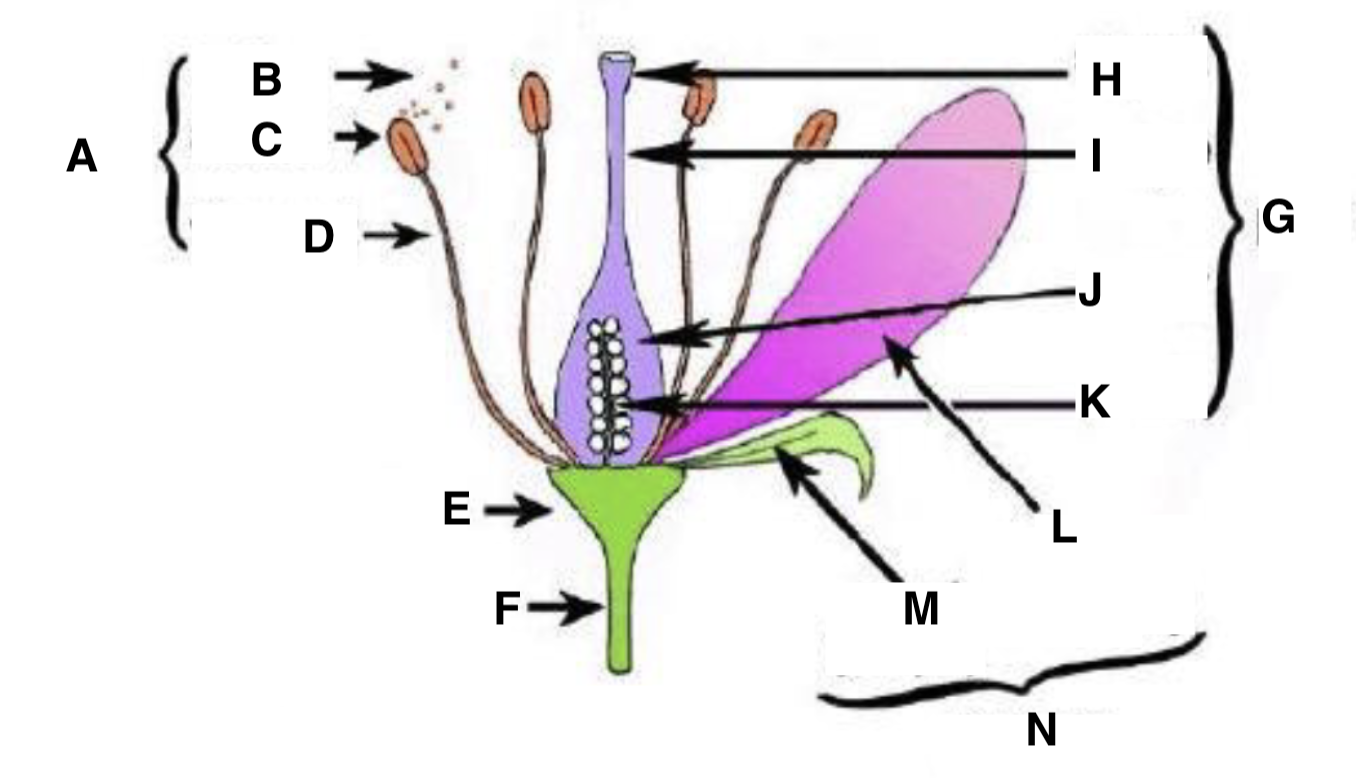
What part of the flower is A
Stamen
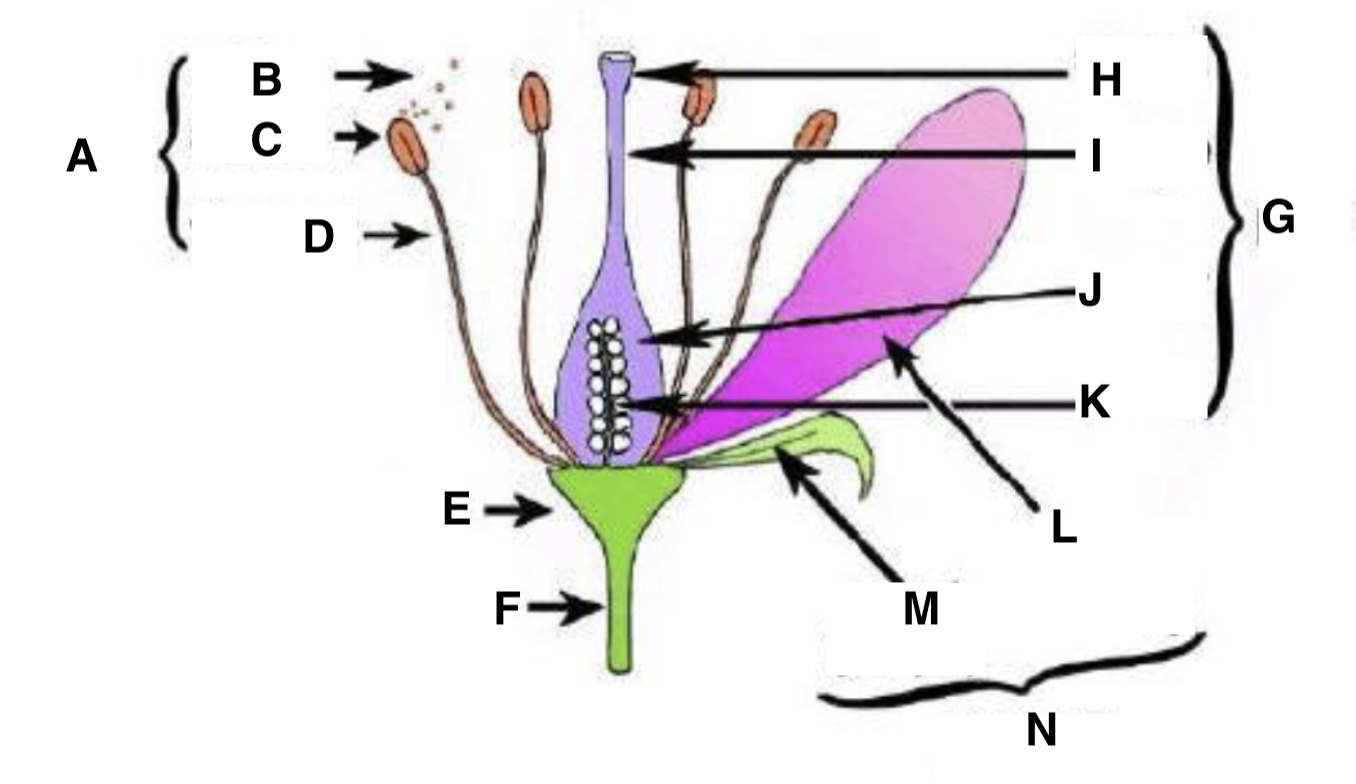
What part of the flower is B
Pollen
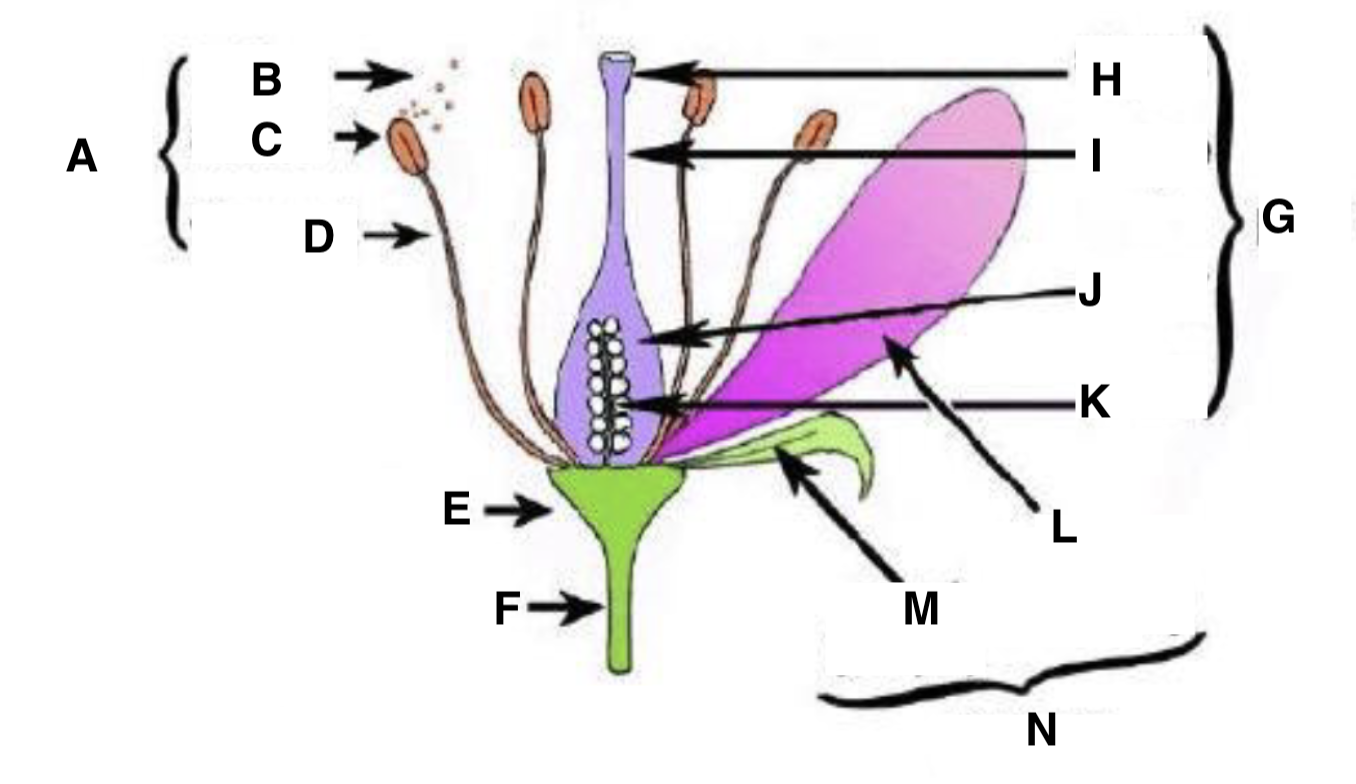
What part of the flower is C
Anther
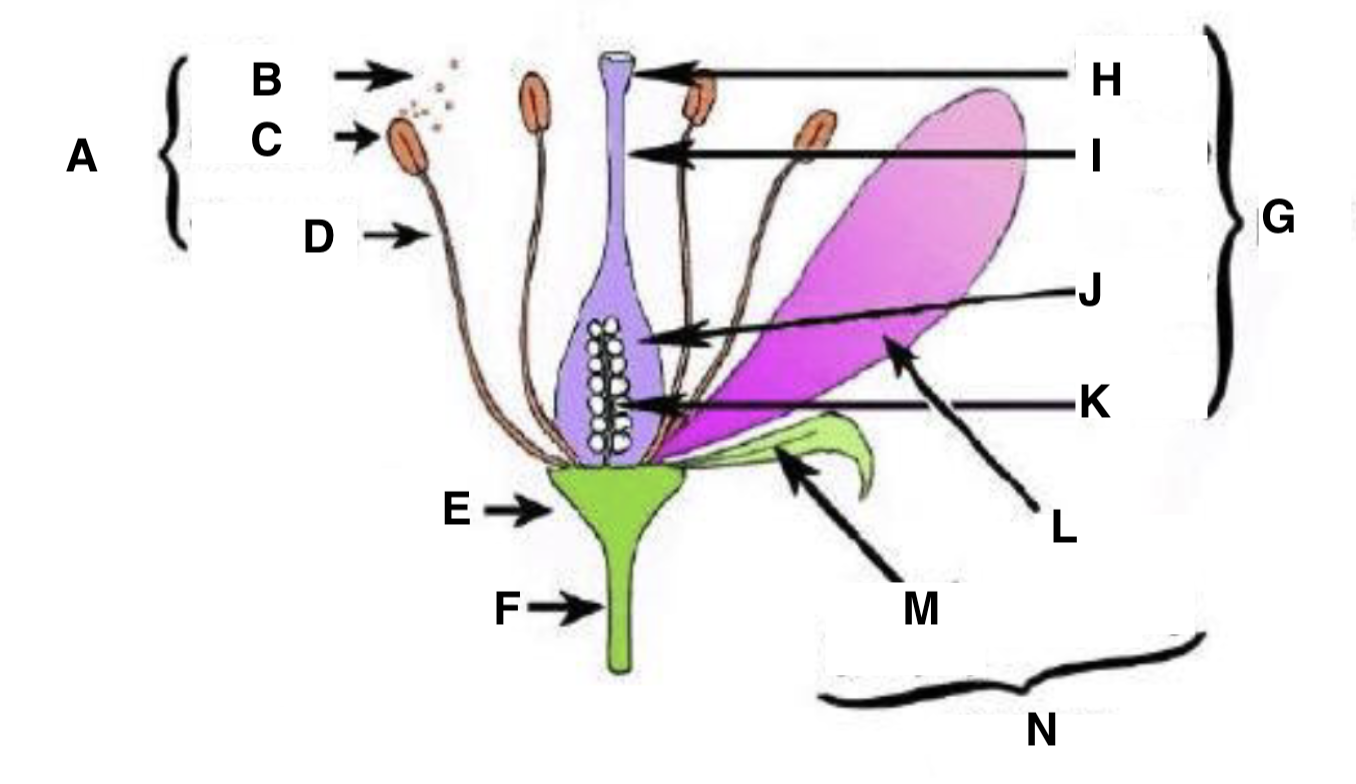
What part of the flower is D
Filament